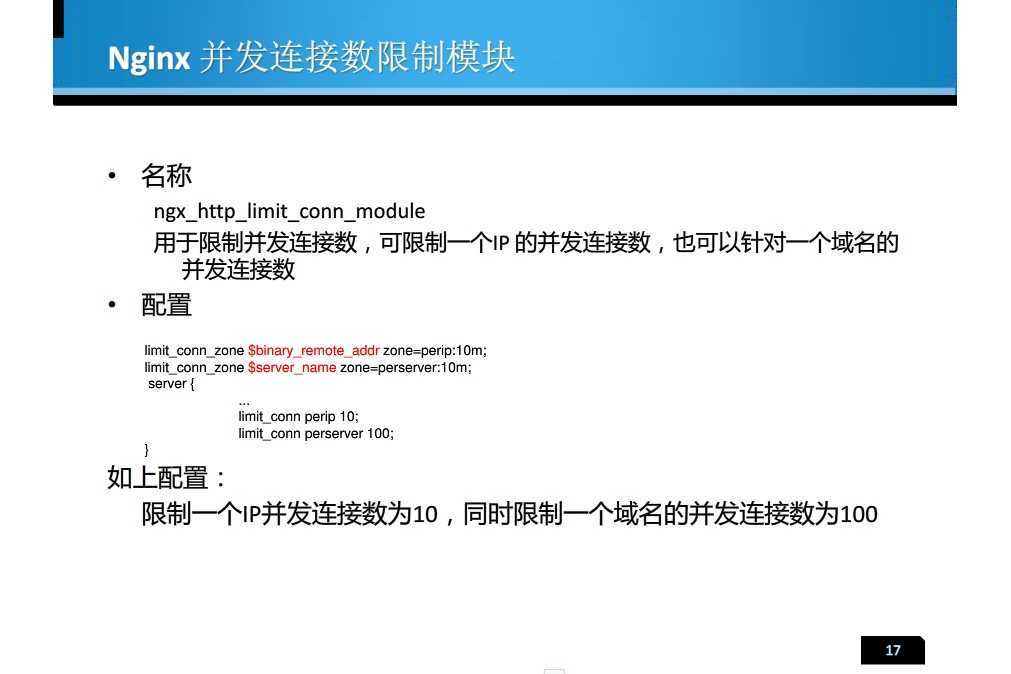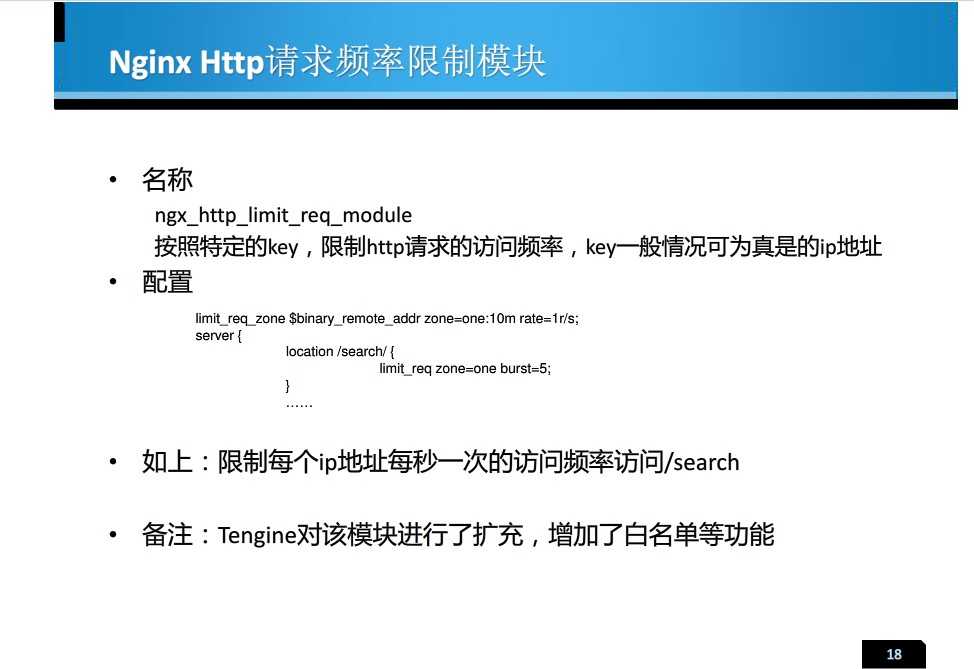1、安装Nginx所需的pcre-devel库
yum install -y gcc gcc-c++
wget ftp://ftp.csx.cam.ac.uk/pub/software/programming/pcre/pcre-8.33.tar.gz
tar zxvf pcre-8.33.tar.gz
cd pcre-8.33
./configure --prefix=/usr/local/pcre
make
make install
2、安装Tengine
yum install openssl openssl-devel
wget http://tengine.taobao.org/download/tengine-1.5.1.tar.gz
tar zxvf tengine-1.5.1.tar.gz
cd tengine-1.5.1
./configure --prefix=/usr/local/nginx --with-http_stub_status_module --with-pcre=/usr/local/pcre-8.33
make
make install
注意:--with-pcre=/usr/local/software/pcre-8.33 指定的是源码包解压的路径
3、配置Tengine
创建用户组和用户
groupadd www
useradd -g www www
编辑主配置文件
vi /usr/local/nginx/conf/nginx.conf
user www www; #指定运行的用户和用户组
worker_processes 4; #指定要开启的进程数,一般为CPU的核心数或两倍
error_log logs/error.log crit; #全局日志 debug|info|notice|warn|error|crit
pid logs/nginx.pid; #指定进程id的存储文件位置
worker_rlimit_nofile 65535;
events {
use epoll; #对于Linux系统epoll工作模式是首选
worker_connections 65536; #每个进程的最大连接数
#在执行操作系统命令"ulimit -n 65536"后worker_connections的设置才能生效
}
http {
include mime.types;
default_type application/octet-stream;
log_format main ‘$remote_addr - $remote_user [$time_local] "$request" ‘
‘$status $body_bytes_sent "$http_referer" ‘
‘"$http_user_agent" "$http_x_forwarded_for"‘;
access_log logs/access.log main;
charset utf-8;
server_names_hash_bucket_size 256;
client_header_buffer_size 32k;
large_client_header_buffers 4 128k; #最大缓存为4个128KB
client_max_body_size 20m; #允许客户端请求的最大的单个文件字节数
sendfile on; #开启高效文件传输模式
tcp_nopush on; #用于防止网络阻塞
tcp_nodelay on; #用于防止网络阻塞
keepalive_timeout 60; #超过这个时间之后服务器会关闭该连接
client_header_timeout 10; #客户端请求头读取超时时间,超过这个时间客户端还没发数据NGINX就返回408错误
client_body_timeout 10; #客户端请求主体读取超时时间,超过这个时间客户端还没发数据NGINX就返回408错误
server_tokens on; #不显示nginx版本信息
include gzip.conf; #HttpGzip的配置文件
include proxy.conf; #配置代理文件
include vhost.conf; #虚拟主机的配置文件
include backend.conf; #配置后端的服务器列表文件
}
limit_req_zone $binary_remote_addr zOne=req_one:10m rate=1r/s;
#10m是会话状态存储空间 rate=1r/s是每个地址每秒只能请求一次 (在vhost.conf还有配置)
limit_conn_zone $binary_remote_addr zOne=req_one:10m;
#设置IP并发 (在vhost.conf还有配置)
编辑HttpGzip的配置文件
vi /usr/local/nginx/conf/gzip.conf
gzip on;
gzip_min_length 1k; #设置允许压缩的页面最小字节数。
gzip_buffers 4 16k; #用来存储gzip的压缩结果
gzip_http_version 1.1; #识别HTTP协议版本
gzip_comp_level 2; #设置gzip的压缩比 1-9 1压缩比最小但最快 9相反
gzip_types text/plain application/x-Javascript text/css application/xml; #指定压缩类型
gzip_proxied any; #无论后端服务器的headers头返回什么信息,都无条件启用压缩
gzip_vary on;
gzip_disable "MSIE [1-6]."; #禁用IE6的gzip压缩
编辑代理文件
vi /usr/local/nginx/conf/proxy.conf
proxy_redirect off;
proxy_set_header Host $host;
proxy_set_header X-Real-IP $remote_addr;
proxy_set_header X-Forwarded-For $proxy_add_x_forwarded_for;
client_body_buffer_size 512k;
proxy_connect_timeout 30;
proxy_read_timeout 30;
proxy_send_timeout 30;
proxy_buffer_size 32k;
proxy_buffers 4 64k;
proxy_busy_buffers_size 128k;
编辑虚拟主机的配置文件
vi /usr/local/nginx/conf/vhost.conf
server {
listen 80;
server_name localhost;
index index.jsp index.htm index.html;
root /usr/local/tomcat7/webapps/ROOT;
location / {
proxy_pass http://backend;
proxy_pass_header Set-COOKIE;
}
location /NginxStatus {
stub_status on;
access_log off;
auth_basic "NginxStatus";
}
}
location ~ .*\.(zip|thumb)$ {
root /usr/local/download;
limit_conn req_one 1; #IP下载并发为1 req_one在nginx.conf中配置的 limit_conn_zone $binary_remote_addr zOne=req_one:10m;
limit_rate 500k; #限速500k
expires 30d;
}
limit_req zOne=req_one burst=100; #req_one在nginx.conf中有配置,当超过rate时请求就会放到burst中burst也满了就503 req_one在nginx.conf中配置的 llimit_req_zone $binary_remote_addr zOne=req_one:10m rate=100r/s;
limit_rate_after 3m;
limit_rate 512k; 这两句话的意思是先以最快的速度下载3MB,然后再以512KB的速度下载。
将扩展名为zip,thumb的静态文件都交给Nginx处理,root为静态文件的目录,而expires用为指定静态文件的过期时间30天。
location ~ ^/(upload|download)/ {
root /usr/local;
expires 30d;
}
将upload,download下的所有文件都交给Nginx处理,upload和download目录包含在/usr/local目录中
编辑后端的服务器列表文件
vi /usr/local/nginx/conf/backend.conf
upstream backend {
ip_hash;
server 127.0.0.1:8080 max_fails=1 fail_timeout=60s;
}
4、设置Tengine开机启动
vi /etc/rc.d/init.d/nginx
#!/bin/bash
# Tengine Startup script# processname: nginx
# chkconfig: - 85 15
# description: nginx is a World Wide Web server. It is used to serve
# pidfile: /var/run/nginx.pid
# config: /usr/local/nginx/conf/nginx.conf
nginxd=/usr/local/nginx/sbin/nginx
nginx_cOnfig=/usr/local/nginx/conf/nginx.conf
nginx_pid=/usr/local/nginx/logs/nginx.pid
RETVAL=0
prog="nginx"
# Source function library.
. /etc/rc.d/init.d/functions
# Source networking configuration.
. /etc/sysconfig/network
# Check that networking is up.
[ ${NETWORKING} = "no" ] && exit 0
[ -x $nginxd ] || exit 0
# Start nginx daemons functions.
start() {
if [ -e $nginx_pid ];then
echo "tengine already running...."
exit 1
fi
echo -n $"Starting $prog: "
daemon $nginxd -c ${nginx_config}
RETVAL=$?
echo
[ $RETVAL = 0 ] && touch /var/lock/subsys/nginx
return $RETVAL
}
# Stop nginx daemons functions.
stop() {
echo -n $"Stopping $prog: "
killproc $nginxd
RETVAL=$?
echo
[ $RETVAL = 0 ] && rm -f /var/lock/subsys/nginx /usr/local/nginx/logs/nginx.pid
}
reload() {
echo -n $"Reloading $prog: "
#kill -HUP `cat ${nginx_pid}`
killproc $nginxd -HUP
RETVAL=$?
echo
}
# See how we were called.
case "$1" in
start)
start
;;
stop)
stop
;;
reload)
reload
;;
restart)
stop
start
;;
status)
status $prog
RETVAL=$?
;;
*)
echo $"Usage: $prog {start|stop|restart|reload|status|help}"
exit 1
esac
exit $RETVAL
保存退出
chmod 775 /etc/rc.d/init.d/nginx #赋予文件执行权限
chkconfig --level 012345 nginx on #设置开机启动
service nginx start
5、其他


CentOS6.4 配置Tengine(转)